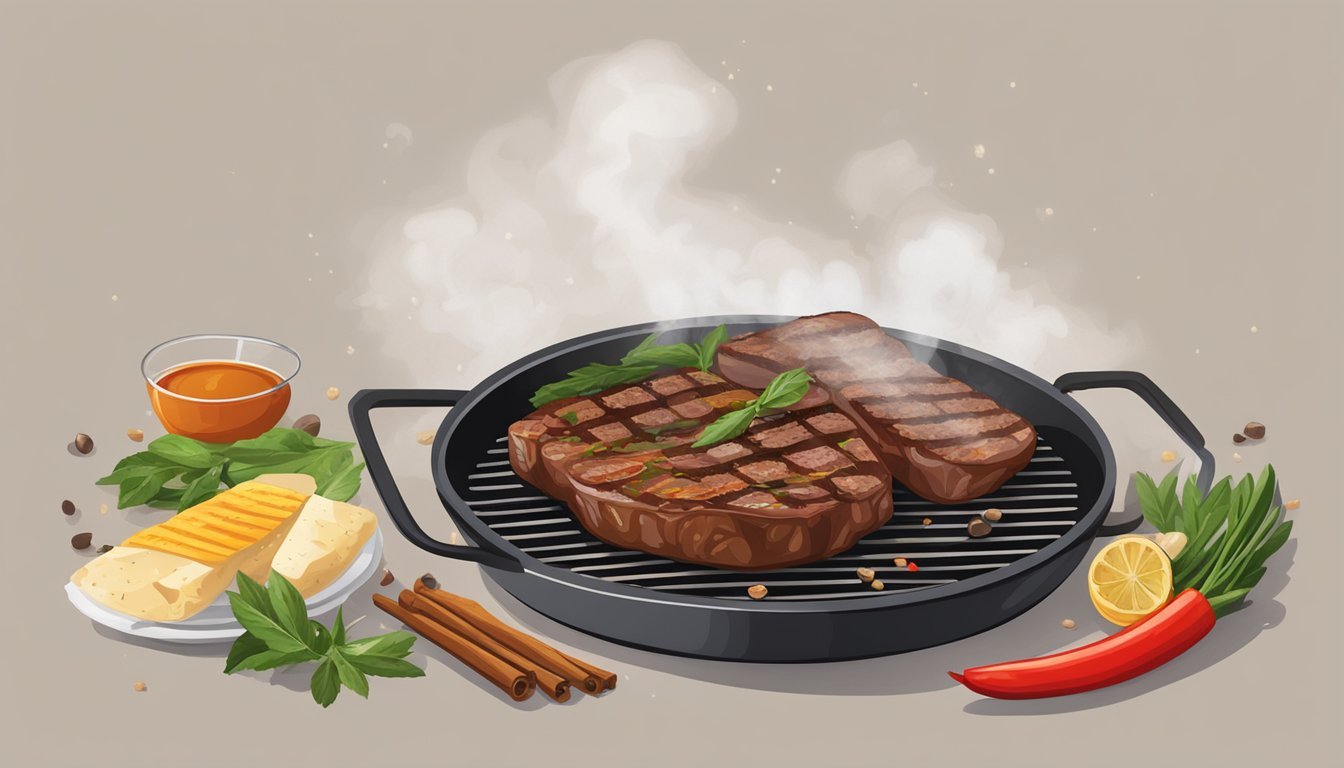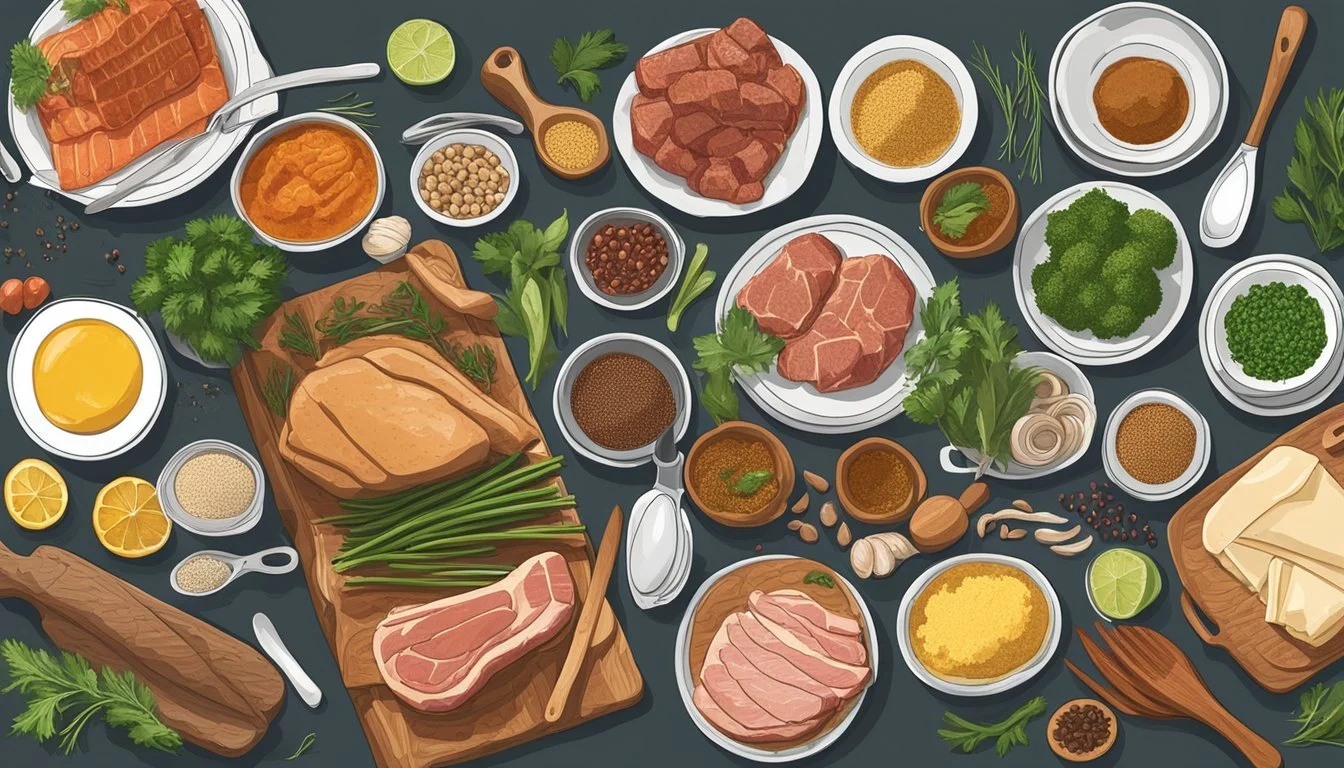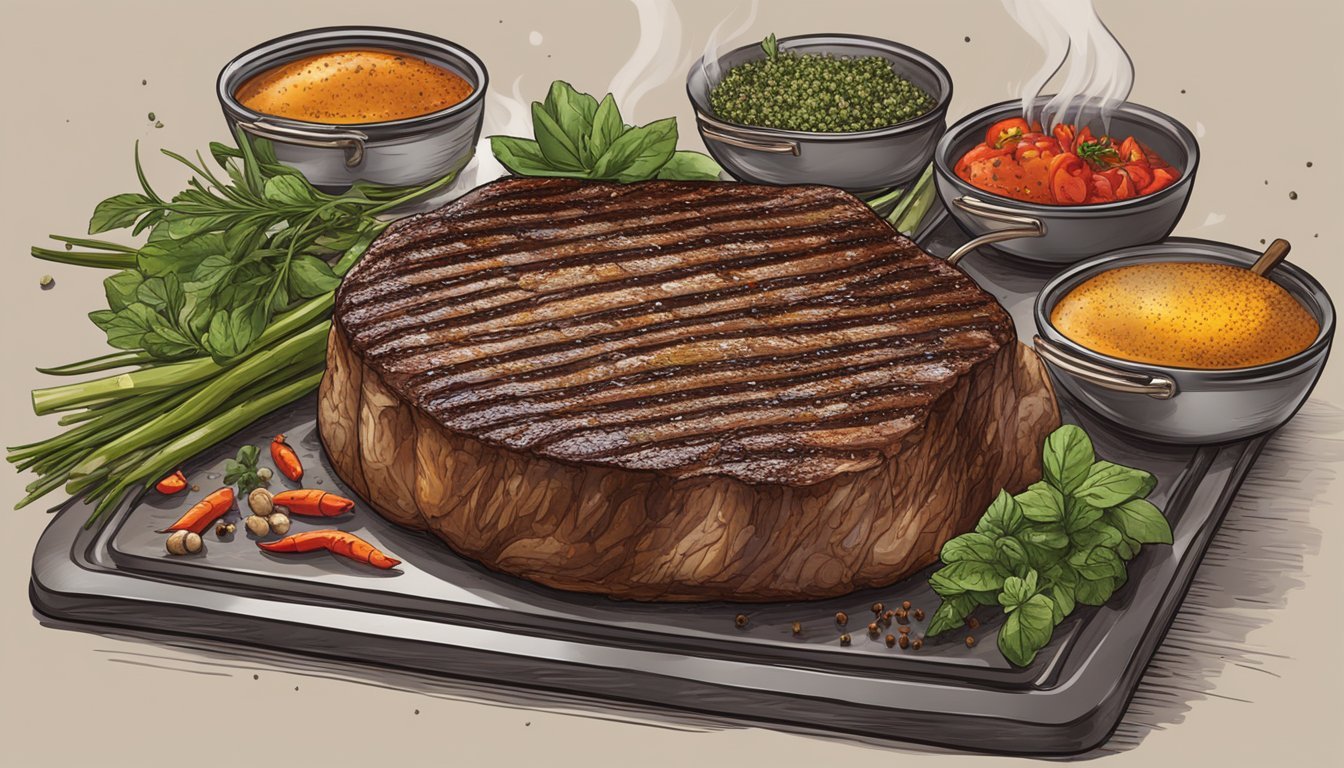How to Spice Up Your Carnivore Diet Meals Without Using Plants
Flavorful Tips and Tricks
The carnivore diet, which consists solely of animal products, can often use a boost of flavor to enhance the enjoyment of its meals. While followers eschew plant-based foods, there remains a selection of seasonings derived from animals or minerals that align with the diet's strict principles. Individuals on this diet seek out creative ways to introduce variety and depth of flavor to their primarily meat-based meals without relying on plant-based seasonings.
Utilizing animal-based seasonings such as bone broth for simmering, or pure animal fats for cooking, provides not only rich flavor but also maintains the integrity of the carnivore diet. Moreover, mineral seasonings like salt—especially unprocessed varieties like Himalayan or sea salt—are fundamental in drawing out the natural flavors of meat. For those who prefer a hint of spiciness, ground black and white peppers, though technically from plants, are often considered acceptable as they are pure spices, used in minimal amounts, and do not contain high levels of carbohydrates or anti-nutrients typically avoided on the diet.
The key is to complement the natural savoriness of meat without overwhelming it, ensuring that each meal remains within the dietary framework while still being palatable and enjoyable. By focusing on the inherent umami and richness of animal proteins and utilizing permissible seasonings, one can achieve a satisfying and varied culinary experience on the carnivore diet.
Understanding the Carnivore Diet
This section delves into the carnivore diet, a lifestyle choice emphasizing meat consumption and excluding plant foods, which purports health benefits and weight loss leveraging a high-protein, low-carbohydrate approach.
Basics of the Carnivore Diet
The carnivore diet is an all-animal-based diet that excludes all plant-based foods. It centers on the consumption of beef, poultry, fish, and other animal products like eggs and certain dairy products. Adherents consume these foods to satiety, aligning with a ketogenic framework that typically leads to a state of ketosis, where the body burns fat for fuel in the absence of carbohydrates.
Primary Foods: Meat (beef, chicken, pork), fish, eggs, and select dairy.
Excluded Foods: Fruits, vegetables, grains, legumes, nuts, seeds.
Health Benefits and Considerations
Proponents of the diet report improvements in digestive issues and reductions in inflammation, attributing this to the elimination of plant-based foods that can sometimes cause gut irritation. Anecdotal evidence suggests potential benefits for weight management, metabolism, and cholesterol levels.
Potential Benefits:
Weight Loss: Due to high satiety and a low-carb regimen.
Gut Health: May improve with the exclusion of irritating plant fibers.
Considerations:
Cholesterol Levels: Individual responses may vary; monitoring is essential.
Vitamin C and Calcium: Intakes should be monitored as certain micronutrients prevalent in plant foods are consumed in lower quantities.
Get the best value for your money by purchasing vitamin C and calcium online!
Carnivore Diet Vs. Other Diets
Comparing the carnivore diet to other dietary approaches, such as ketogenic or standard American diets, the differences lie in macronutrient distribution and food variety. The carnivore diet is similar to keto in its low carbohydrate content but differs by excluding all plants. While the ketogenic diet includes healthy fats from both animal and plant sources like avocados and olive oil, the carnivore diet does not.
Comparison table:
Carnivore Diet
Carbs: Very Low
Plant Foods: No
Animal Foods: Yes
Keto Friendly?: Yes
Ketogenic Diet
Carbs: Low
Plant Foods: Some
Animal Foods: Yes
Keto Friendly?: Yes
Standard American Diet
Carbs: High
Plant Foods: Yes
Animal Foods: Yes
Keto Friendly?: No
Maintaining gut health, achieving weight loss, and managing cholesterol and metabolic rates are considerations individuals may evaluate when choosing a diet that is right for their lifestyle and health goals.
Selecting Quality Meats
Quality meats are central to a well-executed carnivore diet. When choosing meats, one should consider not only the source and quality but also nutritional content, particularly the presence of omega-3 fatty acids which are crucial for health.
Grass-Fed Vs. Grain-Fed
Grass-fed meat generally refers to animals that have been raised on a natural diet of grass, which can lead to a better nutritional profile in the meat. Grain-fed meat, on the other hand, often comes from animals that have been fed a diet of grains, which may include corn and soy. Grass-fed beef tends to have higher levels of omega-3 fatty acids and conjugated linoleic acid (CLA), which can be beneficial for those following a carnivore diet.
Beef: Grass-fed beef is higher in certain vitamins and antioxidants.
Lamb: Lamb naturally grazes on grass, so most lamb cuts like lamb chops are often grass-fed.
Importance of Omega-3 Rich Fatty Fish
Incorporating omega-3 rich fatty fish such as salmon into the diet can be advantageous as these fish provide essential nutrients that may not be as prevalent in other meats. Consuming seafood regularly ensures a balanced intake of both omega-3 fatty acids, which are known for their anti-inflammatory properties, and vitamin D.
Fish: Options like salmon and other cold-water fatty fish are excellent choices.
Seafood: Mussels, (What wine goes well with mussels?) oysters, and other seafood are also good sources of omega-3.
Variety in Meat Choices
Diversity in meat selection can prevent dietary boredom and ensures a range of nutrients. Each type of meat offers a unique nutritional profile:
Beef: Steak offers high-quality protein and iron.
Pork: Pork chops (What wine goes well with pork chops?) provide thiamine which plays an essential part in metabolism.
Lamb: A great source of zinc and B12.
Organ meats: Incorporate organ meats such as liver for a concentration of vitamins and minerals.
Bacon: Although high in fat, it can be included for variety.
By carefully selecting a range of high-quality meats, individuals on a carnivore diet can maintain both meal satisfaction and nutritional balance.
Enhancing Flavors without Plants
Spicing up carnivore diet meals can be achieved using a variety of non-plant techniques. Fats, salt, and certain preparation methods can greatly enhance flavor without introducing plant elements.
Using Fats for Cooking and Flavor
The use of fats in cooking is not only essential for heat transfer but also for adding rich, savory flavors. Common choices for the carnivore diet include butter, lard, and tallow. These fats can be used to sear meats, enrich sauces, or even as a base for basting to add complexity and depth to dishes.
Trust me, the easiest way to buy ghee, tallow, or lard is through online retailers!
Salt: The Essential Seasoning
Salt is the cornerstone of seasoning and plays a critical role in flavor enhancement. Its ability to intensify the natural flavors of meat makes it a non-negotiable component in the carnivore diet. For best results, one can experiment with different types of salt, such as Himalayan pink salt or sea salt, to find the one that best complements their meals.
When it comes to Himalayan pink salt or sea salt, online shopping is the way to go!
Dry Aging and Smoking Techniques
Dry aging meat concentrates the flavor and tenderizes the flesh through enzymatic processes. Smoking meats with non-plant-based fuels like hardwood contributes a distinct smokey note. Both techniques develop rich and robust flavors in the meat without the need for plant-derived seasonings.
Carnivore Diet-Approved Spices and Herbs
Although traditional spices and herbs are plant-based, certain ones might still fit within the carnivore diet framework. Spices such as black pepper and cayenne pepper can be used in moderation to add heat and bite to dishes. Herbs like rosemary and thyme, while plant-based, may be used by some individuals seeking to incorporate minimal plant elements for diversity in flavor.
Discover the endless possibilities of buying black pepper and cayenne pepper online!
Structuring Your Meal Plan
When adopting a carnivore diet, structure is key. A well-thought-out meal plan ensures one consumes varied nutrients while enjoying each meal. This begins with appropriate portioning and extends into strategic meal preparation.
Portioning and Frequency
One must consider portion sizes and meal frequencies to meet daily nutritional needs. Typically, an individual might structure their day around three main meals:
Breakfast: A sizable portion of protein, such as steak and eggs, initiates the day with ample energy.
Lunch: A moderate to large portion, focusing on fatty cuts like roast chicken with skin, provides sustained satiety.
Dinner: A varied portion, possibly including organ meats such as liver, ensures a broad nutrient intake.
Meal frequency can range from two substantial meals to multiple smaller ones, depending on one's energy requirements and digestive comfort.
Meal Preparation Strategies
Approaching meal prep efficiently on a carnivore diet involves:
Variety: Incorporating different animal products, from beef to pork to fish, prevents monotony.
Technique: Utilizing various cooking methods like roasting, slow cooking, and grilling can enhance flavor without adding plants.
Convenience: Pre-cooking proteins in bulk and using simple seasonings like salt ensure meals are easy to assemble.
Here is a basic meal prep structure to consider:
Breakfast
Protein Source: Eggs, Pork Sausage
Cooking Method: Skillet
Remarks: Cook in batches for the week to save time and ensure a quick, protein-rich breakfast.
Lunch
Protein Source: Chicken Breast, Salmon
Cooking Method: Roasting, Pan-frying
Remarks: Pre-season and cook in bulk to have convenient, ready-to-eat proteins for lunch throughout the week.
Dinner
Protein Source: Ground Beef, Liver
Cooking Method: Grilling, Sautéing
Remarks: Incorporating a variety with organ meats for added nutrients and flavor diversity.
By following these guidelines, individuals can maintain a carnivore diet that is both enjoyable and nutritionally complete.
Incorporating Dairy and Eggs
Dairy and eggs offer a range of flavors and nutritional benefits that can enhance the carnivore diet. These animal-derived products provide essential protein, fats, and various vitamins and minerals.
Choosing High-Quality Dairy Products
When selecting dairy products, one should opt for full-fat options such as cheese, butter, and ghee. These items not only provide richness to meals but also supply healthy fats and crucial fat-soluble vitamins like A, D, E, and K. It's recommended to choose raw and organic dairy products where available to maximize health benefits.
Dairy Product Options:
Cheese: Hard and soft varieties for texture and taste diversity
Butter: Grass-fed for higher vitamin K2 content
Ghee: Clarified butter, which is lactose and casein-free, suitable for those with sensitivities
Key Benefits of Eggs in the Carnivore Diet
Eggs are an invaluable component of the carnivore diet due to their complete protein profile and versatility. They are one of the few foods that naturally contain vitamin D, which supports bone health and immune function. Additionally, eggs contain choline, a nutrient vital for brain health.
Egg Variations to Consider:
Boiled: Easy to prepare in advance and consume on the go
Fried in Butter or Ghee: Adds a flavorful fat source to the diet
Scrambled with Cheese: Combines the nutritive benefits of both eggs and dairy
By utilizing dairy and eggs, individuals on the carnivore diet can enjoy a broader palate of tastes while still adhering to dietary restrictions, ensuring meals are both nutritious and enjoyable.
Understanding and Managing Cravings
When one commits to a carnivore diet, cravings for carbohydrates and sugars can pose a challenge. The key strategies involve prioritizing satiety through high-fat, high-protein foods, finding carnivore-friendly alternatives to satisfy specific cravings, and using animal products as a means to mitigate the longing for typical non-carnivore foods.
Staying Satiated with Animal Fats and Proteins
Animal fats and proteins play a pivotal role in suppressing appetite and reducing cravings. Sufficient intake of these macronutrients ensures that the body feels full and energy levels remain stable:
Fats: Opt for fatty cuts of meat like ribeye steaks (What wine goes well with ribeye steak?) or pork belly (What wine goes well with pork belly?) to enhance satiety.
Proteins: Include a variety of meats such as chicken, beef, and fish to maintain muscle mass and metabolic health.
Coping with Sweet and Carb Cravings
The absence of sugars and carbs might trigger cravings, but there are carnivore diet-compliant ways to cope:
Dairy: Incorporate high-fat dairy products, like cheese, which can provide a sense of indulgence without breaking from carnivore principles.
Stay hydrated: Drink water or bone broth to help reduce the intensity of cravings, particularly for sweets.
Alternatives to Common Cravings
To address common cravings on a carnivore diet, one can find animal-based substitutes:
For crunchy textures: Try crispy bacon or pork rinds.
For a creamy experience: Use high-fat dairy like whipped cream or butter.
For a sweet hint: Though true sweetness is limited, small amounts of dairy may offer some relief. However, it's crucial to ensure these conform to one's carnivore diet regimen.
Creative Cooking Techniques
To elevate one's carnivore diet, it's essential to master a range of cooking techniques that can transform the simplest cuts into something extraordinary. The following methods focus on meat's inherent flavors, enhancing them through heat and time.
Grilling and Barbecuing
Grilling imparts a smoky flavor to meats like steak and ribeye, making it a perfect match for the carnivore diet. By adjusting the heat and using direct or indirect grilling methods, one can add a delightful char and a complex taste profile to their meat without the need for plant-based spices or condiments.
Direct Grilling: Ideal for quick-cooking thinner cuts.
Indirect Grilling: Best for larger, thicker cuts that require a slower cook to prevent burning.
Sous-Vide for Ultimate Tenderness
Sous-vide, a technique involving cooking meat in a precisely controlled water bath, allows for an even temperature, resulting in consistently tender and juicy meat. This method is especially effective for cuts that normally turn out tough, enhancing their texture without any additional flavorings.
Temperature Control: Exact temperatures mean never overcooking the meat.
Extended Cooking: Longer cook times at lower temperatures can break down connective tissues without drying out the meat.
Experimenting with Cuts and Cooking Times
Exploring different cuts of meat and their optimal cooking times can reveal a variety of flavors and textures. Thicker cuts like ribeye steaks may benefit from a reverse sear, where they are slowly cooked, then finished with a high-heat sear for a flavorful crust.
Thin Cuts: Quick, high-heat sears lock in flavor.
Thick Cuts: Low-and-slow cooking methods develop depth.
Carnivore Diet in Social Situations
Navigating social situations while adhering to a carnivore diet requires clear communication and strategic choices, especially when it comes to dining out, attending events, and consuming beverages.
Dining Out on the Carnivore Diet
When selecting a restaurant, look for places that specialize in high-quality meats such as steakhouses, barbecue joints, or seafood places. A simple method is to:
Review Menus in Advance: Check online menus to ensure they offer pure meat options without plant-based seasonings.
Communicate with Staff: Politely inform the server of your dietary preferences and inquire about customization options.
Example Order: "Could I please have the ribeye steak, cooked plain with no seasoning or sauces?"
Handling Social Events and Gatherings
Social events and gatherings often come with a diverse array of food choices. To confidently stick to the carnivore diet, consider the following:
Eat Beforehand: If unsure of the available options, have a meal prior to the event.
Bring Your Own Dish: Offer to contribute a carnivore-friendly dish to the meal.
Strategy: Bring a platter of assorted meats and cheeses as a contribution that fits within your dietary needs.
Alcohol and Beverage Considerations
Alcohol and other beverages commonly appear in social settings. The carnivore diet usually limits these options, but there are still some considerations:
Alcohol: Opt for distilled spirits or dry wines that contain no residual sugars if alcohol consumption is chosen.
Coffee and Tea: Plain coffee and tea are generally considered acceptable on the carnivore diet but should be consumed without any additives like sugar or milk.
Beverage Type Carnivore-Friendly Options Alcohol Distilled spirits, dry wines Non-Alcoholic Water, plain coffee, plain tea
Supplementing the Carnivore Diet
Supplementing the carnivore diet can help fill in nutritional gaps that may occur when plant-based foods are excluded. Here's how individuals can ensure that their dietary intake is comprehensive and conducive to health.
Identifying Nutrient Gaps
To maintain nutritional balance on a carnivore diet, it's crucial to recognize what nutrients might be scarce. Minerals like magnesium, potassium, and selenium are often less prevalent in a diet consisting only of animal products. Trace minerals are essential for various bodily functions, including immune system support and bone health, but they may not be adequately obtained from meat alone.
The Role of Bone Broth and Marrow
Bone broth and bone marrow play significant roles in supplementing a carnivore diet due to their rich nutrient profiles. Bone broth, simmered for a long duration, extracts minerals such as calcium and phosphorus. Bone marrow provides beneficial substances like collagen and can be a source of vitamin B12 and fatty acids. They serve as a whole-food supplement, supporting joint health and digestive wellness.
Recommended Supplements and Minerals
Individuals may consider these key nutrients and the following corresponding supplements:
Omega-3 Fish Oil: Supports cardiovascular health and cognitive function.
Magnesium: Aids in muscle and nerve function, as well as energy production.
Sodium: While typically abundant in a carnivore diet, those who sweat heavily or consume very lean meats might need extra sodium.
For a quick reference on these supplements:
Omega-3 Fatty Acids
Benefit: Supports cardiovascular and cognitive health, and may help reduce inflammation.
Source: Fish oil supplements, fatty fish like salmon, mackerel, and sardines.
Magnesium
Benefit: Essential for muscle and nerve function, energy production, and may aid in bone health.
Source: Mineral supplements, nuts and seeds, leafy green vegetables, and whole grains.
Sodium
Benefit: Crucial for maintaining electrolyte balance and proper hydration, as well as nerve and muscle function.
Source: Added salt, electrolyte supplements, or naturally occurring in various foods like cheese and processed meats.
Care should be taken to select high-quality, contaminant-free supplements to avoid adverse effects on health.



















